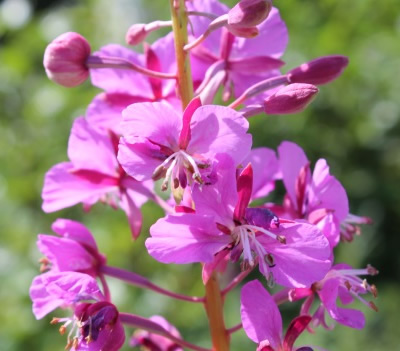Fireweed

Botanical Name: Epilobium angustifolium
Common Name: Fireweed
Other Names: Cillqaq
Found in: Throughout Alaska from low to upper elevations
Physical Characteristics: Tall plant, growing 2 to 5 feet from deep horizontal roots. Leaves are lanceolate and placed alternately on the stem which is simple or occasionally branched. The bright pink flowers have 2 large, rounded petals at the base and 2 slightly smaller rounded petals above. The 4 sepals are long, narrow, pointed, and purplish. The lower flowers on the long graceful raceme are 1 to 1 ½ inches across and bloom first. (Pratt 1989)
Nutritional Value: shoots are rich in Vitamins A and C
Parts of the plant used: shoots, stems, pedals
When plant should be gathered: spring, throughout the summer
Plant applications: infusion/decoction, switch
Reported Benefits: food, childbirth, constipation, colds/flu
Preparation/Processing: Food; shoots are spring greens which are delicious raw or steamed. Jams and / or jellies, and syrups can be made from the flower pedals.
Childbirth, constipation; an infusion/decoction of fireweed tea was drunk by women to stimulate milk secretion or as a treatment for constipation (Birket-Smith 1953)
Colds/flu; Fireweed stems, before flowering or with the flowers removed, were used to switch the chest (while breathing through the mouth) during a steam bath. This was said to be quite helpful if a person was getting a bad cold. This process was repeated for three days. It was noted that fireweed stalks produce more that during switching than many other plants (Russell 1991).
